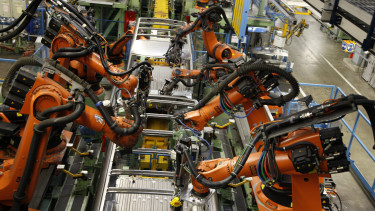Payments to be transformed completely - This is how the money of the future will look like

A couple of words about the Central Bank Digital Currency:
Central Bank Digital Currency (CBDC): Central bank digital currency (CBDC, also called digital fiat currency or digital base money) is the digital form of fiat money (a currency established as money by government regulation or law).
Central bank digital currency is different from virtual currency and cryptocurrency, which are not issued by the state and lack the legal tender status declared by the government. As such, public digital currencies could compete with commercial bank deposits and challenge the status quo of the current fractional-reserve banking system.
Synthetic-CBDC, as defined by Tobias Adrian: A synthetic CBDC is a digital coin provided by a private sector firm, but that has nominal value expressed in the domestic unit of account; is redeemable into cash; is fully backed by central bank reserves protected from the bankruptcy of the coin issuer; and satisfies a number of regulatory requirements. It is essentially a public-private partnership that encourages competition between eMoney providers and preserves comparative advantages. The private sector concentrates on innovation, interface design, and client management. The public sector remains focused on underpinning trust.]
Will we see CBDCs at all in the use by 2040? If yes, will it be retail CBDCs by 2040 or will it be limited to wholesale?
Tobias Adrian: In our view, several countries will introduce CBDCs, and those might not only be for wholesale purposes but retail purposes as well. Now, having said that, there are already certain forms of synthetic CBDCs that are in circulation in countries besides China. Some of the Chinese big tech firms that are offering digital cash for customers have to hold reserves with the People’s Bank of China (PBOC). That is already a form of synthetic CBDC. Normally that is not referred to as CBDC, but economically it is very similar. We believe that there are number of initiatives in other countries as well, for such synthetic CBDCs. The question of whether central banks themselves are going to issue CBDC for retail purposes is not entirely clear. But something that comes very close to that is going to happen.
For wholesale purposes, we do believe that there is going to be some form of CBDCs in the next 20 years.
Tommaso Mancini-Griffoli: It is difficult to predict how many countries are going to issue CBDCs over the next 20 years but as the financial system, the banking system and the monetary system are more and more digitalized, it will become very natural for central banks to offer digital cash.

The two are interrelated and the use of cash is diminishing in some countries as we know it. But we also know that when the use of cash diminishes, it diminishes exponentially due to network effects. The fewer people use cash, the fewer stores will accept cash or have change for cash payments, and the fewer transactions will happen in cash.
Therefore, the use of cash can diminish very quickly when general usage is already low.
Gerrman consumers still hold, as a die-hard habit, 85% of their money in cash. Will cash still have any utility by 2040, or will CBDC be more widespread?
Tobias Adrian: We do see cash usage declining in many countries. The decline is more advanced in some countries than in others. Actually, in the USA cash usage is still fairly high, while many Northern- and Eastern-European countries’ cash usage is going down very quickly. But over a 10-to-20-year period, cash usage is going to decline further.
For central banks the question arises: Should there be a digital form of cash issued by the central bank? That is a very natural question. This might not be happening in the next year or 2 or 3 years, but, over 20 years, we will certainly see more of that happening.
Tommaso Mancini-Griffoli: That is exactly right. The types of questions central banks will ask themselves in a cashless world are:
Is the payment system still sufficiently secure if it is controlled by the private sector?
If it is controlled by a few large private foreign firms, there is the question of security, there is a question of access if one must have a bank account to make payments. We know that is a bottleneck in many countries which causes a problem of financial inclusion and banking sector penetration. These are the type of problems central banks will be facing. In some jurisdictions, the answer may be to counter those problems with digital cash that is backed by the central bank. In other jurisdictions, the answer may be that we don’t feel like the benefits outweigh the costs. It will be a decision made country by country.
Do you see that consumers will have universal bank accounts at the central banks by 2040? If yes, will commercial bank accounts still hold any value?
Tommaso Mancini-Griffoli: This goes to how you design a central bank digital currency. We would not suggest jumping to the conclusion, that the appropriate design is to offer a bank account to each individual at the central bank.
That is one way to do it, but it would be a very costly one, and a relatively risky one. It is not the central banks’ primary capacity to interact with customers and take on the risks that are associated with that.
So, another way that we offer is synthetic CBDC.
That is essentially a public-private partnership. The private sector would offer the payment token: Therefore, it will be in charge of interfacing with the clients of choosing a technology, maintaining it, dealing with brand recognition, dealing with associated risk. That’s the private sector: They are good at interfacing with customers, they are good at innovation. The public sector and the central banks would allow the private sector to access their reserves.
This means that the coins issued by the private sector would be backed by central banks reserves. The central bank is good at this: offering trust. So, this partnership would be focused on their respective value-added. It is a partnership that is likely less costly and risky for the central banks from a reputational standpoint. It’s another way to offer CBDC, but, at the end of the day, the public comes very close to holding and transacting with a central bank liability. It is very similar in nature with what we used to call central bank digital currency.
Will we see retail CBDCs competing with the current fractional reserve banking system of commercial banks in 2040, or do we see more of a synthetical-CBDC trend growing with the rise of stablecoins? Also, in the case of synthetic CBDC, will commercial banks or fin-tech companies fill the intermediary role?
Tobias Adrian: Let me start with the fact that banks and the financial intermediation that banks are offering is crucial for economic growth, for capital allocation, for investments and savings. We do not see a future without the banking system. We do foresee that the fractional reserve banking system will exist.
The other point is that banks are innovators in the fintech space just as much as start-ups. Every single international bank has major investments in fintech. Some of the most visible ones, for example, is the JPMorgan coin. In this case, JPMorgan uses distributed ledger technology (DLT) to construct a payment system among its institutional clients.

I would expect that banks would continue to innovate along these dimensions. It’s not that clear whether a new entrant, rather than an existing bank, would dominate that fintech space in the future.
Does digital cash have any raison d’être if we have real-time settlement systems?
Tobias Adrian: There is a question of the order of magnitude. With the fintech innovations, we are moving towards real-time settlement systems. It is essentially a free payment system that is instantaneous. Then the question arises:
Do you even need digital cash if you have instantaneous payments from account to account?
In our view, yes. There is still a room for digital cash, but it might not be quantitively that large. We might want to hold some amount of digital cash in your wallet, but it’s not that significant.
These days, you can have an app from your bank, a savings account, a money-market account and a traditional bank account.
One day, people could also have a digital cash account with a digital cash wallet.
In the United States, and in other countries as well, it’s sort of interesting, as there are money market funds, which are somewhat similar in nature to digital cash. They are very liquid, you can write checks on your money market account, you can instantaneously transfer money from your money market account to your trading account in many arrangements.
Even though these money market accounts pay higher interest rates than deposit accounts, they are still limited in size, they are much smaller quantitively than bank accounts. We do think there is a room for it, but how large is it, is not entirely clear.
It is also a question of policy choices — for example, whether central banks pay interest on reserves on a stablecoin. For example, in the case of China, AliPay is required to hold central bank reserves against their floats, but they get 0% interest rates. With this, they pass on the 0% interest rate to the customers, so in this way, it is really similar to cash.
What would be the risks of CBDC for the consumers? What do these currencies have to fulfil as requirements?
Tobias Adrian: The key word about the monetary system is trust. Banks and financial systems are built on trust. You are willing to have paper cash in your pocket, because you have paid for that paper cash, to be able to buy objects, even though it’s just paper. You hold money in your bank account because you trust that you can retrieve that money anytime.
The question is, that how do digital cash generate trust. That is why the devil lies in the details. We like the notion of synthetic central bank digital currency because there is the trust of the central bank that is standing behind the reserve. If the reserves are held in Treasury bills, in banking deposits, or in other investments than there is some form of liquidity transformation, thus some degree of uncertainty whether you are going to get your money back that you are holding at that institution.
We believe that to make CBDC successful, it has to be completely trustworthy, just as much as euro bills are trustworthy. That is an important benchmark.
If this trustworthiness is fulfilled, what advantages will consumers experience in their everyday life?
Tobias Adrian: We live digital lives. If you think about it, the way we transact is way different from how we transacted 20 years ago, and it certainly will change in the next 20 years. Smartphones, digital phones, and the internet play a huge role in our daily life. Digital cash is designed for our digital lives.

I think that the customer experience would change, and potentially improve, if digital cash were widely used. The way that retailers and the financial industry are catering to consumers, it could potentially improve our daily lives.
Tommaso Mancini-Griffoli:
We could see gains in speed, a reduction in costs, an increase in convenience.
It is important to point out perhaps, that these days assets are migrating to the blockchain in order to save on back-office functions. Digital cash, which would also exist on the blockchain, would be an interesting way of trade in assets. Actually, it would be a really widespread case potentially of digital cash as opposed to what we currently have today.
Trust, in itself, is incredibly important, which suggests that the use of CBDC must not necessarily be especially widespread to serve a very important purpose. This purpose is offering the ability for other means of payment to be converted to CBDC. Trust in any privately issued payment, depends on the ability to transform that means of payment at will into a government liability that you trust in all states of the world. CBDC might offer exactly that function in the digital world. Even if CBDC is not widely used, as long as it’s there, it can serve an incredibly important purpose.
Will central banks have to develop an independent communication strategy and marketing tools to familiarize consumers with CBDCs?
Tommaso Mancini-Griffoli: A lot depends on how you design CBDCs. If the central banks are branding a new product and are offering accounts directly on their books to users, then they will definitely have to set up a new communication channel.
It might even have to set up a hotline that consumers can call in case of trouble.
Tobias Adrian: However, the idea that we are pushing, though, is one where CBDCs will not require the central banks to do any of that.
They would operate in the background, and there would either be banks or fintech company operators or even telecom operators that would be the interface for the consumers.
The central bank thus would not be directly involved, but the central bank would still be in the background that provides the trustworthiness.










